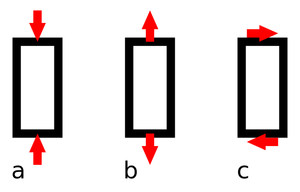Shear
Introduction[edit | edit source]
- Forces are NOT moving in opposite or approximating directions exclusively. This is a COMBINATION of tension and compression. A shear strength is applied parallel to the surface of an object, creating internal deformation in an angular direction. Maximum shear stresses act on the surface parallel to the plane of applied strength.
Effect on bones[edit | edit source]
- In bones (anisotropic structures), failure occurs more quickly when exposed to a shear force rather than a compressive or tensive forces. For example: spondylolisthesis, in which one vertebra slips over another previously. In the lumbar spine, shear strength by vertebrae, increases with increasing lordosis and with hyperlordosis. The pull of muscle on the lumbar vertebrae also creates an increasing shear strength on the vertebrae.[1]
- Shear fractures are common to be noticed in tibial or femoral condyles that are usually due to knee hyperextension with fixed foot and a valgus (medial) force on the thigh or shin. In the developing child, this shear strength may create epiphyseal fractures, such as the distal femoral epiphysis. In adults, this shear strength may create a fracture + injury in the collateral or crossed ligaments (e.g. ACL ruptures).
- When shear is the primary motion occuring, the body often lacks sufficient ways to attenuate this stress and may lead to degenerative changes over time or perhaps even acute tissue rupture.
Shear forces in Joints[edit | edit source]
1- Shoulder:[edit | edit source]
The largest ratios of shear force component to compression force component are computed for activities such as reaching across the body, picking and placing everyday objects, pulling and pushing , sitting and standing as well as cleaning the back. These results suggest that glenohumeral shear force components are substantial not only when high loads act at long lever arms but also at high angles of arm elevation[2].
2- Elbow[edit | edit source]
Excessive shear forces or moments were found during push up with hands in internally rotated position so this position should be prevented so as to avoid these injurious forces or moments.[3]
References[edit | edit source]
- ↑ Tarun Goswami. Human musculoskeletal biomechanics / monograph. Rijeka: Intech; 2011.
- ↑ Klemt C, Prinold JA, Morgans S, Smith SHL, Nolte D, Reilly P, et al. Analysis of shoulder compressive and shear forces during functional activities of daily life. Clinical Biomechanics [Internet]. 2018 May 1;54:34–41. Available from: https://www.sciencedirect.com/science/article/pii/S0268003318302146
- ↑ Lou SZ, Lin CJ, Chou PH, Chou YL, Su FC. Elbow load during pushup at various forearm rotations. Clinical Biomechanics. 2001 Jun;16(5):408–14.







